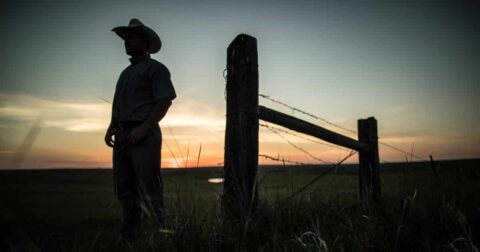News
Our Favorites Stories of 2025
Food•5 min read
Reported
Regenerative grazing's central claim—that a properly managed herd will restore soil health and save the planet—has garnered a lot of attention lately. But some are still deeply skeptical.


Words by Claire Hamlett
A properly managed herd of cows will restore soil health and save the planet. This, broadly speaking, is the claim of the regenerative grazing movement, a form of livestock agriculture popularized by the Zimbabwean livestock farmer and founder of the Savory Institute, Allan Savory, as the key to reversing desertification and climate change. It has garnered a lot of attention following the August 2020 release of the documentary Kiss the Ground—some of it rapturous, some of it deeply skeptical.
Regenerative grazing, also called holistic grazing, involves cattle grazing for a short time on a small area of land before they are moved on to fresh pasture, allowing the grazed land to recover with the help of the cattle’s trampling activity and manure. This is supposed to mimic the ecological function of large migratory herbivores like bison whose populations have been hugely reduced by human activity.
Among the biggest criticisms of regenerative grazing is that it is not supported by science, with results from individual pieces of land unable to be replicated—a criterion that any climate solution should ideally meet. Critics also say that regenerative grazing is simply not scalable because it would require too much land. For cattle to mimic the movements of migratory animals like bison, they would need to be able to move over huge swathes of land, potentially requiring further deforestation than has already occurred for industrial agriculture. Instead, freeing up land from producing food through a global shift to plant-based diets would allow forests and other ecosystems to be restored.
Grazing is in fact only one of a range of practices falling under the broader concept of regenerative agriculture (RA). Soil scientist Rattan Lal has noted the ability of RA to improve soil health and carbon storage capacity but cites a multitude of practices such as no-till and cover cropping, which do not require the presence of cows or other herbivores. He also says that RA should be used to reduce the impact of food production on the land. “The goal of RA is to apply the concept of more from less to agriculture and produce more from less,” says Lal. “The strategy is to spare land and resources for nature.”
Even though regenerative grazing does not, on current science, seem to be quite the miracle solution some make it out to be, farmers who practice it are often motivated by personal experiences and deeply held beliefs about nature and their role in helping to heal the land and find value in it that goes beyond how much carbon it can store. And as an alternative to industrial animal agriculture, it is easy to see why regenerative grazing would be so appealing to some.
There are many victims of the industrialization and intensification of agriculture, including farmed animals, wildlife, and the exploited workers of the meat and dairy industries. For farmers, the toll is both financial and emotional. As food production has become concentrated in the hands of a few huge agribusinesses that control everything from the supply of animal feed to the processing of meat, farmers who once had independence are now beholden to corporate interests. This has left many in debt as the agribusinesses force them into exploitative contracts. Farmers have described the situation as being in “hell,” reducing them from business-owners to “serfs” who have to farm in ways that don’t agree with their values. Regenerative agriculture offers some farmers a way to opt-out of this system, since they no longer need to depend on products from agribusinesses to run their farms like synthetic fertilizers and animal feed.
Chris Jones, who owns Woodland Valley Farm in Cornwall, England, became aware of the damage being wrought on the environment by industrial agriculture decades ago. He clearly despises the intensive confinement of livestock that now produces the majority of the world’s meat, using words like “diabolical” to describe it.
After taking over his family farm in 1990, the outbreak of mad cow disease in the UK forced him to downsize his herd of cattle as beef prices plummeted. That change put him on a journey to organic farming, but a “carbon audit” of his farm in 2008 made him see that being organic wasn’t enough. He says that since switching to this regenerative grazing and giving up farming crops, his farm has gone from emitting more than 300 tonnes of carbon a year to “having a net sequestration of about 350 tonnes.”
His herd of 60 dairy cows rotates around his 170-acre organic farm, grazing on grasses and herbs on grassland and in a 26-acre woodland pasture, which is called “silvopasture.” Project Drawdown, a non-profit that evaluates climate solutions, describes silvopasture as five to ten times more powerful at sequestering carbon and offsetting methane emissions from livestock than treeless pastures. Silvopasture can, to some extent, allay concerns about how regenerative grazing at scale would result in more deforestation to make way for grazing animals, but not all woodlands will benefit from the presence of such animals. Research shows that “unmanaged” forests with undisturbed soils can be an effective carbon sink. A review of recent scientific literature by the Rewilding Institute concludes, “Conserving unmanaged wild forests is a useful, scalable, and cost-effective complementary strategy to the continued conservation of well-managed woodlands.”
One of Jones’s more radical views is that we should stop producing beef cattle. Instead, the UK should “have really good native dairy cows that can eat just grass,” he says. “We’ve got a little Jersey cow here and she’s giving us averaging probably 15, 16 liters of milk a day, just off that one cow. And it’s exceptionally good food that she’s producing. And she’ll have a calf every year. Now, if the calves are what become the basis for the beef, rather than having specialist beef animals, that would probably be a sensible sort of national way to go.”
Jones seems to disagree with Rattan Lal’s assessment of RA as a tool to “spare land and resources for nature,” believing that a piece of land that produces food through, for example, livestock grazing woodland pasture with fruit and nut trees can do as good a job of storing carbon and creating wildlife habitat as a great ecosystem that produces no food. “And I just don’t think we can afford the latter,” he says. But he does believe in the coexistence of wildlife and agriculture. He is a director of the Beaver Trust, and in 2017 he introduced a pair of beavers on his farm. He has been critical of the government’s sluggishness in embracing the beaver as a powerful means of improving the country’s biodiversity and managing its increasing susceptibility to severe flood events.
“I am a very serious ecologist,” he says. “I am a very serious believer in keeping the maximum biodiversity that we possibly can. But I’m also very keen that we actually reduce our emissions as much as we possibly can our sort of global emissions. And that means agriculture has got to play its part.”
Across the Atlantic, Philip Wagenbach grew up in a farming family much like Jones did. He realized early on that it would be healthier to feed cows on grass than on grain but every farmer he talked to about it told him there was no future in it. “So I didn’t get anywhere with that. There was really no opportunity,” he says, though he was “disgusted with where agriculture was going: get big [or] get out,” he adds, quoting the mantra of Richard Nixon’s Secretary of Agriculture Earl Butz, who supported the corporatization and mechanization of American farming. But Wagenbach’s family played by the rules of Big Ag, only to lose their farm anyway. The expansion of factory farming across America has seen hundreds of family farms subsumed into the industrial machine over the years.
At that point in his early twenties, Wagenbach retrained as a healthcare professional with a focus on preventative medicine, which led him back to his first passion: grass-fed beef. When teaching heart attack survivors about fats, he found that everyone in the class would say they had been told they could no longer eat red meat, but when he asked who would actually never eat it again, “there was only about one in 20 who said they would never eat red meat again and probably 70 percent said they’re not changing, period. They’re gonna eat burgers and … it’s not going to be grass-fed, right?”
Still, he knew that grass-fed beef would be the healthier option. “When the animals are really, truly being managed on healthy pasture, they can gain fast and have a really high-quality product that’s healthy,” he says. “The health benefits are actually in the fat, not in the lean.” Few will be surprised to learn that beef from cows fed on diverse plants on pasture is indeed healthier than that from cows fed on soy and corn as they are in America’s industrial feedlots. So Wagenbach moved to Vermont to start farming again. There, he grazes his cattle on diverse forage, moving them around the pasture in ways that are the most beneficial to the animals and the health of the soil.
The health benefits are not the only aspect that draws Wagenbach to regenerative grazing. The experience of his family losing their farm to agricultural industrialization and corporatization has made him an advocate for bringing more people back to smaller-scale farming. “What regenerative agriculture looks like is way more meaningful work,” he says. “There [are] days where I’m pretty sure we’re committing some kind of crime by eliminating jobs,” as has occurred in farming as it has become increasingly mechanized. “What would be wrong with having a lot more folks actually laboring, working the soil.”
While regenerative grazing should perhaps form only a small part of the way food is produced in the future, part of its value can be found in the way its practitioners are willing to adapt and experiment to achieve the greatest benefits for society and nature. As Jones says, “I just think we’re in so much trouble now, we can’t afford to treat any sector as being separate and sacrosanct. And so we’ve got to be looking at things holistically.”